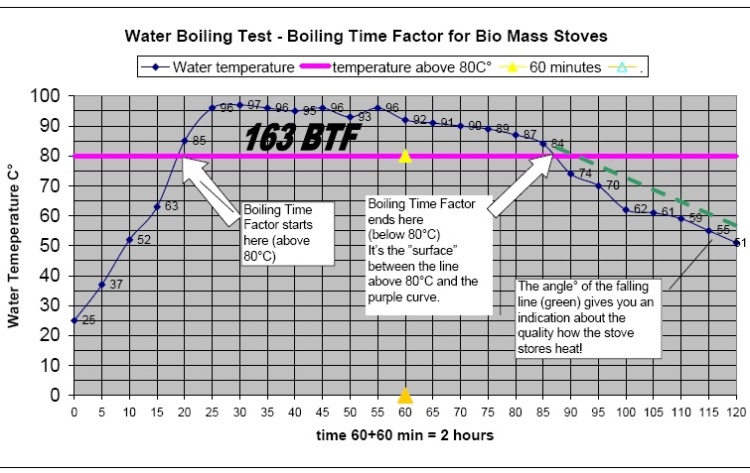
Water Boiling Test for cooking stoves - using the "Boiling Time Factor" / BTF
I want to make a proposal for a new Stove-Testing-Concept using the "Boiling Tine Factor"
(BTF)
In a word: You use the size(number) of surface of the temperature curve as an indicator for the quality of the stove!
This means a simple "number" stands for the quality of the stove!
This number I call " BTF=boiling time factor "
I can draft a curve of the temperature over time. And i take into account the surface of the temperature curve above 80°C This is normally the temperature which is
helpful for cooking.
The temperature is taken every 5 Minutes. The test goes over a period of 2 hours. All the fuel is used during the first hour. That means that after the end the second
hour- all the fuel is completely burned.
No need to search for left-over pieces charcoal- like in other testing procedures.
What's the idea behind this stove testing method?
I worked with fuel saving stoves in 1982 and 1985. I always disliked the ARLINGTON STOVE TESTING PROCEDUREs from 1982 because it means:
stopping the fire, weighting the charcoal, starting the fire (continuing) the fire from new.
Especially for larger community stoves with bigger fire I really found this method improper.
The BTF procedure takes into account:
* if the stove is a low-mass or a high-mass stove.
* It takes into account if the stove heats up quickly
* It takes into account if the stoves keeps the heat after the fuel is burned. (Also the chimney quality/damper
effectivity).
This is because no fuel is added after one hour- during the 2nd hour. A quick drop of temperature (smaller surface) indicates a not-so-good stove.
If the temperature is kept for a while (= larger surface of the curve above the purple 80°C line) this gives an indication for a good stove.
So once more:
1) The stove testing times goes over 2 phases: One hour of heating and one more hour when no fuel is added.
2) You start to make a quick fire and reach the boiling point quickly. Afterwards the fuel is evenly distributed for the remaining 1st hour.
3) The amount of water boiled should always be the same (2 litres for family stoves, 15 litres for community stoves).
4) The fuel is taken by volume (e.g. an empty can of about 1,5 litre) but the weight is also excactly noted. (1,5 litre for family stoves, 11,5 litres
for community stoves, but details on the volume and weight of the fuel still needs some re-thinking).
5) The water evaporated is measured in case a "Percentage heat utilized" figure wants to be calculated.
However the objective of the BTF is not to evaporate water- but to heat up water quickly and to keep it up hot above 80°C over an extended period in relation
to
-a fixed amount of water and - a fixed amount of fuel.
Calculations:
There is no need to use integral calculations for finding the "surface above 80°C", simple use this formula: add up all temperatures
minus-80°C every 5 minutes. (Only count the temperatures which are above 80°C). The first and last temperature number needs to be taken as 1/2.
Sample: 20min= 85°C, 25min=96°C, 30min=97°C, 35min=96°C, 40min=95°C, 45min=96°C, 50min=93°C, 55min=96°C, 60min=92°C, 65min=91°C,
70min=90°C, // 75min=89°C, 80min=87°C, 85min=84°C, ,
BTF, Boiling time factor: 5*1/2 +16+17+16+15+16+13+16+12+11+10+ 9+ 7+ 4*1/2 = 162,5 = ~163
If you want to add a comment, go the the 3rd page "adam-retort kiln" to add a comment, thanks...


